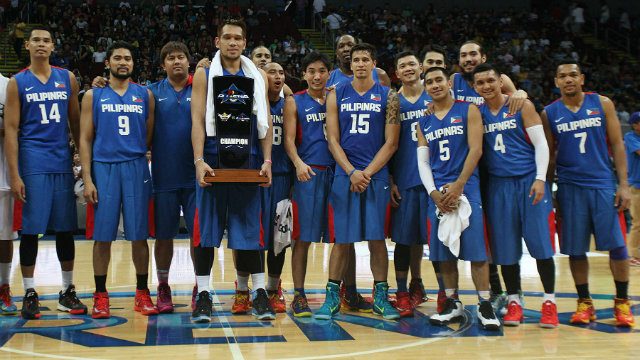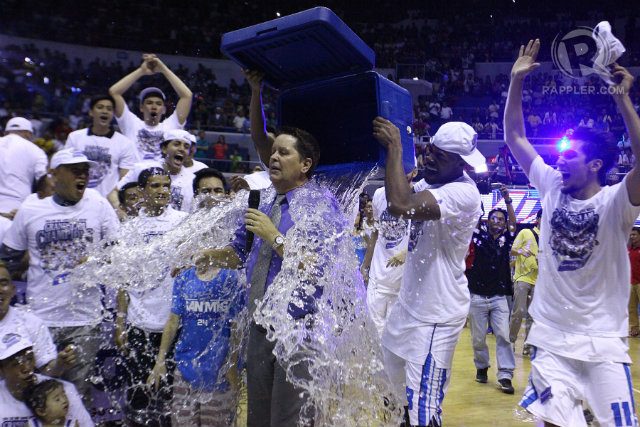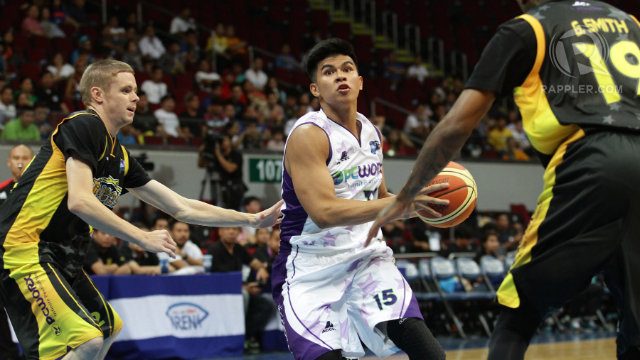SUMMARY
This is AI generated summarization, which may have errors. For context, always refer to the full article.

MANILA, Philippines – It’s crazy to think how everything went downhill for Gilas Pilipinas in a heartbeat.
As September 2014 rolled around the corner, hopes were high in the Philippines. For the first time in 36 years, the Philippine men’s national basketball team would participate in the grandest stage of international basketball: the FIBA World Cup. In Seville, Spain, the team made the most out of their opportunity playing in the bright lights of World basketball.
Gilas Pilipinas battled against tough opponents. They held big leads against European counterparts only to falter in the final quarter. It was an inspired effort that nobody expected from them. Despite several close calls, Gilas managed to win just one game. The team finished the preliminary round with 1-4 record but what they accomplished in Spain went beyond what any digits show.
Gilas fought toe-to-toe against more celebrated teams like Argentina, Puerto Rico, Croatia, and Greece. Their FIBA ranking jumped from no. 34 to no. 31 after the World Cup, and you could make the case they should have been placed higher.
With each game, they brought together legions of Filipinos scattered around the world, sharing hugs, laughs, and tears for two and a half hours for consecutive days.
It felt like fate had intervened and granted Gilas their time to shine in the big stage. The Philippines had arrived, and the world was supposed to watch out.
And then the Incheon Asian Games happened, resulting to one of the darkest stretches in the basketball program’s history.
There were the heartbreaking losses to Iran, Korea, and Qatar. There was the Kazakhstan game where the Philippines disrespected the unwritten conducts of basketball by trying to score points for their own opponents in an effort to salvage their campaign. There was the public feud between Coach Chot Reyes and Marcus Douthit that tarnished the reputations of both men who were celebrated and admired by the country.
Gilas finished seventh in the Asian Games, which was much lower than where the team wanted to end up. Sure, fatigue set in and forced guys like Jimmy Alapag and Marc Pingris to sit out a few games. And there was the loss to Korea which the Philippines could have won had Douthit been in action rather than riding the bench as a disciplinary measure. The team also had scarce recovery time in between the World Cup and Asian Games.
But there were too many blown double-digit leads and too many distractions outside of the court. The consequences proved vital, as Coach Reyes lost his job a few weeks later after it was announced the Gilas program will be “re-evaluated.” He then “requested” for his name to be withdrawn from consideration, guaranteeing not only a new mentor for the team but also a new era for the program.
Regardless of who’s hired to be the next head coach or next batch of players to represent the country, what’s certain is that the future still looks bright for Gilas Pilipinas.
Find a leader
The Samahang Basketbol ng Pilipinas (SBP) built a selection committee tasked with appointing the new head coach of Gilas Pilipinas. This group includes SBP Vice Chairman Ricky Vargas, SBP Executive Director Sonny Barrios, PBA Commissioner Chito Salud, PBA Chairman Pato Gregorio, and PBA Vice Chairman Robert Non.
“The composition of the committee are right-minded persons who are knowledgeable in the basketball community,” Barrios told Rappler.
The group already has a criteria on choosing the next mentor for the team but has yet to come up with a shortlist, he added.
Once the criteria is approved by the SBP’s executive committee, the team can start coming up with candidates to take over the Gilas coaching position.
Assuming they fit the criteria, two of Reyes’ former assistants in Jong Uichico and Norman Black will likely be considered for the job, or at least warrant deliberation when coming up with a shortlist. Uichico coached the national team during the 2002 Asian Games where the Philippines finished fourth. Black has yet to spearhead a national team.
The biggest argument for either of the two will be continuity. Both Uichico and Black are accustomed to the dribble-drive offense used by Reyes while he coached Gilas, and the former still uses it now with the Talk ‘N Text Tropang Texters in the PBA.
It’s clear how important familiarity and continuity are key with developing a basketball program and keeping it successful for the long run. Think of how many consecutive years the San Antonio Spurs have been in the NBA championship discussion because they kept their core intact under the same head coach.
Gilas’ future teams will have a different set of players compared to the ones that competed in the 2014 World Cup and Asian Games. But having a reliable system in place that has proven to work in the international stage means not having to rely solely on the talents of the guys making up your team.
“Nag-work naman eh,” Gilas shooter Jeff Chan said of the dribble-drive system. “Siguro napagod lang. Kasi yung preparation namin for the World Cup, one and a half month kami away sa family [namin], sa Pilipinas. Pag dating sa World Cup, medyo buhos lahat. Siguro duon kami napagod, tapos after two, three weeks, may Asian Games naman. Kulang yung rest and preparation namin for the Asian Games.“
(Our system worked. I guess we were just tired. We were a month and a half away from our families and from the Philippines preparing for the World Cup. When we were at the World Cup, we gave it everything we had. We got tired because of that and then after two, three weeks, there was the Asian Games. We did not have enough time to rest and prepare for that.)
Tab Baldwin, an American coach who was with Gilas during their World Cup and Asian games journey, has been a popular mention for the Gilas coaching spot. He doesn’t lack international experience, having coached the Australian, Jordanian, and Lebanese national teams and leading them to titles. And unlike Uichico, Black, or Tim Cone (more on him later), Baldwin wouldn’t need to worry about leaving a PBA head coaching job behind if the Gilas gig was offered to him.
Leading the national basketball team should be a full-time occupation. We know how tough it’s been for PBA franchises and its players to manage time and proper rest in between conferences and international tourneys. What else for a head coach, who besides spending hours in practices with his team also has to watch so much film, come up with offensive and defensive sets, and concentrate on building good relationships with each of his players. Juggling a PBA squad and a national squad has too many demands, even for the best of the best.
That best of the best is Tim Cone.
Cone for Gilas
Cone already told Rappler: “I haven’t heard anything or been contacted by anyone,” with regards to the Gilas head coach opening.
But whatever criteria the SBP decides on, they would be crazy not to give Cone a call to at least see if he’s interested.

Cone’s resume speaks for itself: He’s an 18-time PBA champion, the best in league history. There have been only four Grand Slam teams in the PBA’s 40 years of existence and he coached two of them.
Rarely is he involved in an issue with one of his players like how Coach Chot was with Douthit during the Asian Games. Almost all of his players, colleagues, and media haven’t been shy telling the public how much respect they have for him. His system need not to be questioned. After all, it has produced so many championships. He was also called the “foremost apostle” of the Triangle Offense in an SB Nation article.
Reading all those accomplishments makes you wonder, “what else does Cone need to win in the PBA, really?” Baby Dalupan is the second coach in PBA history with the most championships after winning 15 titles in his career. Black is third overall and second to Cone among active coaches with 11. He isn’t catching coach Tim anytime soon.
Cone is already regarded by many as the greatest coach in Philippine basketball history. Winning more in the PBA would make pad his resume, but it would not enhance his legend any more because he’s already accomplished nearly everything a coach can in the league.
But if he led the national team to a gold in the FIBA-Asia Championship, and then garner a few wins in the 2016 Rio Olympics, they might just have to make a statue of him outside the Smart Araneta Coliseum.
Cone guided the 1998 Philippine team to a gold medal finish in the Jones Cup and bronze medal finish in the Asian Games, so international experience shouldn’t be a problem. However, coaching Gilas is a full-time gig. Would he be willing to leave Purefoods in the PBA to take the job? Would his San Miguel Corporation bosses allow it? Cone already said his Purefoods players are available for national duty, but is he?
Whoever coaches the national basketball team will need to be a tactician who can compete with the rest of the world. He needs to be able to make smart decisions against other knowledgeable and experienced coaches. And most of all, he needs to be a leader of men. It’s hard to predict how long from now the SBP will decide who the next Gilas coach would be, but as of this moment Cone seems like the most logical choice to take the job.
The stars of tomorrow
On November 5, Allen Iverson was the star of the night at the Mall of Asia Arena during his “All In” basketball charity game.
The former NBA MVP didn’t do much other than hold a media session and then coach a team of Ball Up all-stars against a team led by Cone and a few notable college players in the Philippines in what turned out to be a very exciting game.
Cone’s boys were at a disadvantage from the get-go. The streetball stars were more experienced and more athletic. But when the final buzzer rang, it was Cone’s team that came out on top. Thanks to some late heroics from Kiefer Ravena, the college kids made an evening that was already special (because they met Allen Iverson) even more exceptional with a victory they can look back to for the rest of their lives.
They did that thanks in large part to Ravena, who did what he’s done so many times in his young career: take the game in his hands, face the pressure, carry his team on his shoulders, and lead them to the W.
On a night where Allen Iverson was the main attraction for the country to see, it was Kiefer Ravena who grabbed the spotlight.
But he didn’t do it alone.
“Ang sarap kasama nang mga to. Ibang klase yung feeling. Kahit nasa bench ka. Especially under Coach Tim, ibang klase,” Ravena said after the game, which he played alongside some of his collegiate rivals: Jeron Teng, Mac Belo, Troy Rosario, and Ola Adeogun, to name a few.
(It’s a great feeling to play alongside your rival. Everyone thinks its all business when it comes to me and Jeron, but there’s a deeper story into our friendship that people wouldn’t believe until they meet us.)
When Ravena and Teng’s team was making their comeback , there was a play where the two college superstars – who went no. 1 and no. 2 in the latest UAAP men’s basketball season MVP race – executed a perfect fastbreak that got the crowd up on their feet.

“That’s the future of Gilas right there,” the guy to my left, my editor, said. He’s right. Maybe 5, 6 years from now when it’s time for a new cast of national team members to proudly don the Pilipinas jersey. Ravena and Teng will be up for the task along with other talented young stars: Belo, Rosario, Baser Amer, Earl Thompson, and many more. The future of Philippine basketball is bright, especially with this group of young and rising prospects.
What this game showed is Cone’s ability to lead a quickly assembled team to victory against a team who had been together for a while and possess physical gifts Filipino athletes can only dream of having.
“I like any of these guys. They’re all really good players. Jeron and Troy, I like Troy a lot, Mac of course and these guys, they can all play. CJ [Perez], I thought, was impressive as well. I think they’re all going to be excellent pros,” Cone said after the game.
“Kiefer’s hands down a special player. He’s like a Johnny Abarrientos, one of those once-in-a-genaration type of players that comes around. If you can get him, you’re going to thank your lucky stars.”
“Ravena’s going to be a mainstay in the national team for years to come, that’s for sure.”
The Gilas Pilipinas program looked dim after the Asian Games. But the future is still bright, even with the many questions surrounding the program right now. There are many coaches who would be suitable to take over the job, and many player choices that would make the team competitive. The same can be said for the batch of players that will be in their primes in 5 or 6 years and ready for national duty. Blatche’s return will be important, and hopefully the SBP can get other naturalized players in the future with the same talent level.
The World Cup was tremendous. It was like waking up on Christmas morning to many gifts, delicious hot chocolate, and beautiful Christmas carols. Then the Asiad came around, and those great memories from Christmas were replaced by the depressing reality of having to go back to work the next day. All those losses were a sucker punch to the gut, but it doesn’t mean what the national team accomplished was a one-hit wonder.
There will be many more games and tournaments to get excited about. Sure, there will be more heartbreaking defeats that will have Filipinos crying themselves to sleep. That’s natural in the world of sports. But there will be the good times as well. Moments that will be created for everyone to remember even far into the future.
– Rappler.com
Add a comment
How does this make you feel?
There are no comments yet. Add your comment to start the conversation.